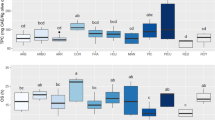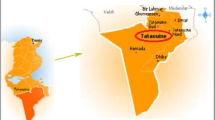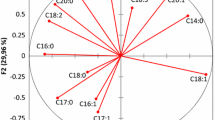Abstract
Quality characteristics (acidity, peroxide value, K 232, K 270, ΔK, oxidative stability index) and chemical data (antioxidant compound, fatty-acid, sterol, erythrodiol-uvaol, and wax compositions) were studied in monovarietal virgin-olive oil samples (2004–2005 harvests) from different regions of Argentina. The data obtained according to standard methods were compared with international quality and purity criteria. The total-polyphenol content ranged from 25 to 263 mg/kg, showing the highest values for Coratina and Arauco oils. The α-tocopherol content varied between 160 and 428 mg/kg; these values are generally stated to belong to good quality oils. Most of the samples from the new productive zones failed at least one purity criterion. Arbequina samples presented the highest deviations from the International Olive Oil Council criteria in fatty acids, waxes, and sterol percentages, indicating a poor adaptation of this cultivar to the agronomic medium and its sensibility to adverse climatic conditions. Principal component analysis revealed that the harvest-year influence was attributable to environmental factors.



Similar content being viewed by others
References
International Olive Oil Council (accessed November 2006) Trade Standard Applying to Olive Oils and Olive-Pomace Oils. COI/T.15/NC No. 3/Rev. 1, 2003, http://www.internationaloliveoil.org
Aparicio R, Roda L, Albi MA, Gutiérrez F (1999) Effect of various compounds on virgin olive oil stability measured by Rancimat. J Agric Food Chem 47:4150–4155
Aparicio R, Morales MT, Alonso V (1997) Authentication of European virgin olive oils by their chemical compounds, sensory attributes, and consumers’ attitudes. J Agric Food Chem 45:1076–1083
Stefanoudaki E, Chartzoulakis K, Koutsaftakis A, Kotsifaki F (2001) Effect of drought stress on qualitative characteristics of olive oil cv Koroneiki. Grasas Aceites 52:202–206
De la Torre-Boronat MC, López-Sabater MC, Collel-Areny J (1985) Evolución de la fracción esterólica durante la maduración de las aceitunas. Grasas Aceites 36:198–202
Jiménez de Blas O, Del Valle-González A (1996) Determination of sterols by capillary column gas chromatography. Differentiation among different types of olive oil: virgin, refined, and solvent-extracted. J Am Oil Chem Soc 73:1685–1688
Gutiérrez F, Varona I, Albi MA (2000) Relation of acidity and sensory quality with sterol content of olive oil from stored fruit. J Agric Food Chem 48:1106–1110
Kiritsakis AK (1998) Olive oil. From the tree to the table, 2nd edn. Food & Nutrition, Trumbull
International Union of Pure, Applied Chemistry (IUPAC) (1992) Standard methods for the analysis of oils, fats and derivatives, 7th edn. Blackwell Scientific Publications, Oxford
AOCS (1993) Official methods and recommended practices of the American Oil Chemists’ Society, 4th edn. The American Oil Chemists´ Society, Champaign
International Olive Oil Council (accessed November 2006) Spectrophotometric Investigation in the Ultraviolet. COI T.20/Doc. No. 19/Rev. 1, 2001, http://www.internationaloliveoil.org
Gutfinger T (1981) Polyphenols in olive oils. J Am Oil Chem Soc 58:966–968
Mínguez-Mosquera MI, Rejano-Navarro L, Gandul-Rojas B, Sánchez-Gómez AH, Garrido-Fernández J (1991) Color-pigment correlation in virgin olive oil. J Am Oil Chem Soc 68:332–336
International Olive Oil Council (accessed November 2006) Preparation of the Fatty acid Methyl Esters from Olive Oil and Olive-Pomace Oil. COI/T.20/Doc. No. 24, 2001, http://www.internationaloliveoil.org
International Olive Oil Council (accessed Nov. 2006) Determination of the Composition and Content of Sterols by Capillary-Column Gas Chromatography. COI/T.20/Doc. No. 10/Rev. 1, 2001, http://www.internationaloliveoil.org
Official Journal of the European Union, DO L248 (05.09.1991). On the Characteristics of Olive Oil and Olive-Residue and of the Relevant Methods of Analysis. Annex VI: Determination of erythrodiol and uvaol contents, pp 28–29
International Olive Oil Council (accessed November 2006) Determination of Wax Content by Capillary Column Gas Chromatography. COI/T.20/Doc. No. 18/ Rev. 2, 2003, http://www.internationaloliveoil.org
Alba J, Hidalgo F, Ruiz MA, Martínez F, Moyano MJ, Cert A, Pérez MC, Ruiz MV (1996) Características de los aceites de oliva de primera y segunda centrifugación. Grasas Aceites 47:163–181
Aguilera MP, Beltrán G, Ortega D, Fernández A, Jiménez A, Uceda M (2005) Characterization of virgin olive oil of Italian olive cultivars: “Frantoio” and “Leccino”, grown in Andalusia. Food Chem 89:387–391
Gandul-Rojas B, Cepero MR, Mínguez-Mosquera MI (2005) Use of chlorophyll and carotenoid pigment composition to determine authenticity of virgin olive oil. J Am Oil Chem Soc 77:853–858
Salvador MD, Aranda F, Fregapane G (1998) Chemical composition of commercial Cornicabra virgin olive oil from 1995/1996 and 1996/1997 crops. J Am Oil Chem Soc 75:1305–1310
Gracian T (1968) The chemistry and analysis of olive oil. In: Boekennogen HA (ed) Analysis and characterization of oils, fats and fat products. Wiley, New York
Alderete-Salas S, Gómez PE, Matías AC, Moyano PL, Luna MC, BenítezJ, Dalla Lasta F, Montalbán LD (2004) Influencia de las condiciones ambientales en la composición de ácidos grasos de los aceites de oliva virgen de Catamarca. Aceites Grasas 55:336–342
Rivera del Álamo RM, Fregapane G, Aranda F, Gómez-Alonso S, Salvador MD (2004) Sterol and alcohol composition of Cornicabra virgin olive oil: the campesterol content exceeds the upper limit of 4% established by EU Regulations. Food Chem 84:533–537
Koutsaftakis A, Kotsifaki F, Stefanoudaki E (1999) Effect of extraction system, stage of ripeness, and kneading temperature on the sterol composition of virgin olive oils. J Am Oil Chem Soc 76:1477–1481
Gómez MSG (2001) Composición química de las distintas calidades de aceites de oliva virgen de la variedad “Empeltre” en el Bajo Aragón. Grasas Aceites 52:52–58
Ranalli A, Angerosa F (1996) Integral centrifuges for olive oil extraction. The qualitative characteristics of products. J Am Oil Chem Soc 73:417–422
Christopoulou E, Lazaraki M, Alexiou F, Synouri S, Frangiscos E (1996) Influence of certain factors on the composition of olive-pomace oils. Part II Sterols, triterpenic dialcohols and aliphatic alcohols. Riv Ital Sostanze Grasse LXXIII:201–211
Sánchez-Casas J, Osorio-Bueno E, Montaño-García AM, Martínez-Cano M (2004) Sterol and erythrodiol + uvaol content of virgin olive oils from cultivars of Extremadura (Spain). Food Chem 87:225–230
Koutsaftakis A, Kotsifaki F, Stefanoudaki E, Cert A (2000) Estudio sobre las variaciones de determinados parámetros químicos y de los componentes menores de los aceites de oliva virgen obtenidos de aceitunas recolectadas en distintas fases de maduración. Olivae 80:22–27
Hamilton RJ (1995) Plant waxes. In waxes: chemistry, molecular biology and functions. The Oily Press, Scotland, pp 211–212
Acknowledgments
This work has been supported by ASAGA (Asociación Argentina de Grasas y Aceites), CONICET (Consejo Nacional de Investigaciones Científicas y Técnicas), and Universidad Nacional del Sur, Argentina. We gratefully thank Martha Melgarejo, who was an interlocutor with the productive sector staff, giving the instructions about sample collecting and providing trustworthy cultural and processing data.
Author information
Authors and Affiliations
Corresponding author
About this article
Cite this article
Ceci, L.N., Carelli, A.A. Characterization of Monovarietal Argentinian Olive Oils from New Productive Zones. J Am Oil Chem Soc 84, 1125–1136 (2007). https://doi.org/10.1007/s11746-007-1140-7
Received:
Revised:
Accepted:
Published:
Issue Date:
DOI: https://doi.org/10.1007/s11746-007-1140-7




